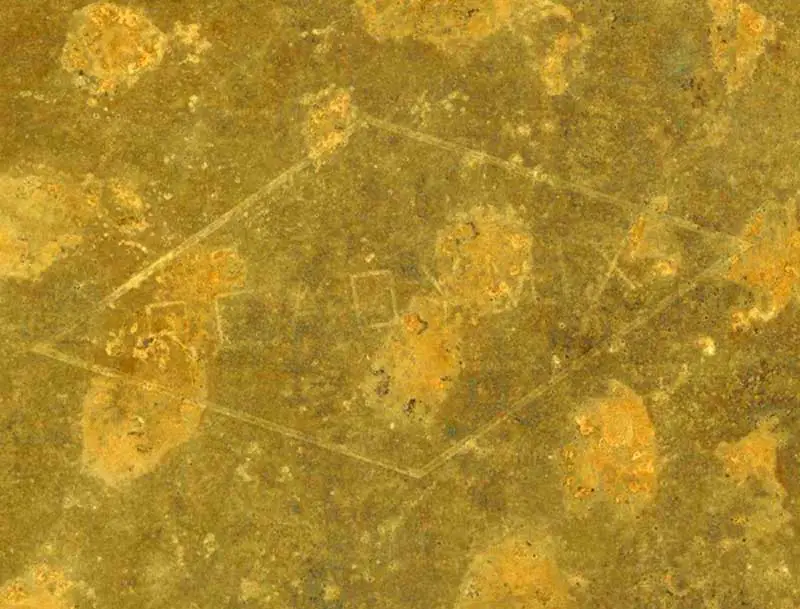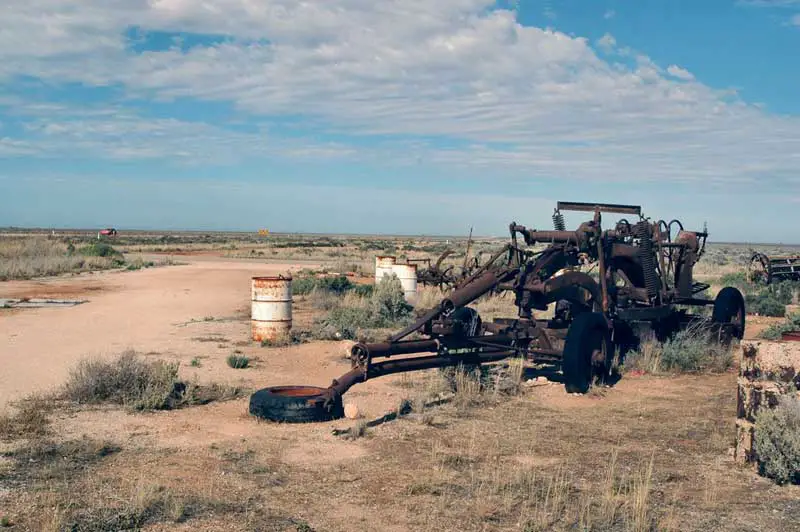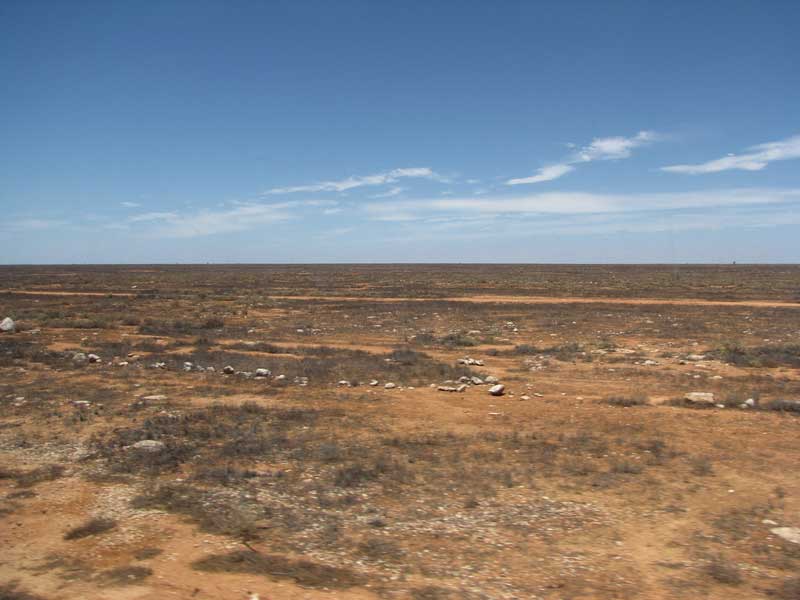
A Readymix Logo, carved into the limestone bedrock of the Nullarbor Plain, was created in the winter of 1965 by construction crews sealing the Eyre Highway across the Nullarbor Plain. Situated 13km north west of the John Eyre Motel at Caiguna some 800 kilometres east of Perth near the midpoint of the Eyre Highway, it is the work of Allan Hoare (1936-89), a grader driver. It is said to have been created as an emergency airstrip for Readymix employees, the logo making it easily identifiable from the air. Readymix apparently owned its own twin-engined Aero 145, a Czech aircraft, and had long-term charters of various Cessna 185, 310, and 400 models for crew changes. The site was never used as an airstrip and is a long way from the road and Caiguna settlement, so this may have been a myth generated to cover up that it had been created purely for advertising purposes or out of boredom.
The “diamond in the desert”, which is on the Nightshade pastoral lease, was once a familiar sight along what used to be the trans-continental flight route. Ansett and TAA domestic flights used Caiguna’s VOR station as a turning point on routes to and from Perth, so the logo was visible to crew and passengers on flights between Perth and the eastern capitals. A track can be seen running from the southeast, up to the western vertex of the diamond. This was presumably the starting point for its creation. Another track, presumably an antecedent farm-track, runs slightly northwest of vertical across the centre of the logo.
The diamond shape measures 3.2km across by 1.6km high. Inside the diamond, the word ‘Readymix’ was listed in the Guiness book of records between 1972-1992 as the largest lettering in the world, with interest being revived in it with the advent of satellite imaging.

An old grader at Balladonia Station, believed to have been used to carve the Readymix logo
While the diamond was maintained by “occasional grading” from soon after its creation, by the mid-1970s, the diamond was becoming overgrown. John Crocker, owner of Balladonia station, was subsequently employed, and regraded it several times until about 1980. Crocker took several days to do the job each time. The diamond’s edges required 10-12 cuts and the letters required five. The maintenance grading was initially permitted by the MacLachlan family, who first became aware of the logo when their sheep musterers stumbled across it. But permission was revoked about 1980 due to the regrading “further exacerbating terrible degrading created by Main Roads on both sides of the highway”. Once more the diamond began to fade. Increases in aircraft size, coupled with modern navigational technology, allow aircraft now to fly direct to Perth from the eastern states, across the Great Australian Bight, no longer needing to remain over land for navigation purposes. So by the 1980s scheduled domestic flights no longer overflew the logo, and it was left to deteriorate unseen, except for occasional scenic joyflights over it offered by the John Eyre motel. By 1998, the diamond was barely visible, and the letters all but overgrown.
Even the Guinness Book of Records lost interest. The category of “Largest letters” last appeared in the thirty-seventh “1991” edition, Readymix still holding the title. Hugh MacLachlan, the head of Nightshade stations’ lessees, Jumbuck Pastoral, remained opposed to re-establishing the diamond, asserting that besides previous damage to an electric dog fence by Readymix employees, the grazing value of the land is marginal enough, and would be adversely impacted by the sign. By 1998, the diamond was barely visible and remains that way, although it still survives on a number of maps, including some issued very recently. It can be viewed using Google Earth.

What is believed to be part of the Readymix logo on the Nightshade pastoral lease
Readymix Ltd had been founded in Sydney in 1939 as the Ready Mixed Concrete Co., expanding into quarrying in 1957 with the purchase of Australian Blue Metal (ABM) Ltd. In 1964, the Colonial Sugar Refining Co (after 1973 CSR Ltd) bought a half share in Readymix, as part of its own expansion into building products. In 1981 CSR acquired the remaining half share of Readymix, and merged its quarrying and concrete operations to form Readymix-Farley. This was renamed CSR-Readymix in 1988.
Readymix won each annual tender by the Main Roads Department of Western Australia to undertake quarrying operations along the Eyre Highway during its sealing, beginning at Balladonia in July 1964. About 1965, probably in winter, the decision was made to construct a giant rendition of the Readymix company logo virtually exactly halfway along the Eyre Highway, north of the 225 mile peg. One of the quarry surveyors was given the task of marking the logo out, and Allan Hoare, a grader driver, graded it into the plain over a holiday weekend. The grader easily cut through the few inches of soil, revealing the white limestone bedrock underneath. The absence of trees or large rocks obviated any need for bulldozing prior to grading, or rolling afterwards.
It is located on the Nightshade pastoral lease, but permission was not given by the MacLachlan family, the lessees, although it may have been granted informally by the station manager at the time. The station was first leased only in 1963, and was not fenced off from the Eyre Highway until the mid-1980s so that there was probably no indication that the land was not open range.
The suggestion that the logo might not have been an airstrip has been rejected both by Readymix (WA) Ltd’s staff and former regional manager. He has stated that that he was present on a company aircraft, flying from Kalgoorlie to inspect the highway work, which was forced by bad weather to make a choice whether to land on the existing clay strips rendered dangerous by the weather, to make an emergency landing on the highway, or to turn back. Therefore he himself ordered the construction of the emergency strip for reasons of safety and efficiency. He admitted that the diamond was probably never used for emergency landings, although its presence at least provided greater peace of mind both to Readymix’s pilots and executives. After the completion of the sealing of the Eyre Highway on the Western Australian side in 1969, the diamond would no longer have been needed as an airstrip, and subsequent maintenance appears to have been solely to retain its advertising and aerial landmark functions.









